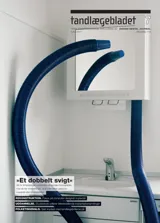Fjernelse af zygomaimplantat
Baggrund – Zygomaimplantater kan anvendes ved kraftig atrofi af processus alveolaris posteriort i maksillen. Herved kan rehabilitering ofte foretages uden forudgående knogleopbygning. Fjernelse af zygomaimplantater kan være nødvendigt på grund af infektion. Beskrivelse af patienttilfælde – En 59-årig mand blev henvist til Tand-, Mund- og Kæbekirurgisk Afdeling, Århus Universitetshospital, for fjernelse af et zygomaimplantat på grund af periimplantitis og recidiverende sinuitis. Implantatet blev fjernet i generel anæstesi via såvel intraoral som ekstraoral adgang. Herved blev implantatet fjernet i flere stykker med trepanbor. Det postoperative forløb var komplikationsfrit. Konklusion – Fjernelse af det pågældende zygomaimplantat nødvendiggjorde intraoral og ekstraoral adgang i generel anæstesi. Der var således tale om en omfattende operation med potentiel risiko for alvorlige komplikationer hovedsageligt på grund af tæt relation til orbitaindholdet. Endvidere er der ikke udviklet specialudstyr eller beskrevet procedurer til dette formål. Selvom der ikke opstod komplikationer efter fjernelse af zygomaimplantatet i nærværende patienttilfælde, bør zygomaimplantater udelukkende anvendes, såfremt knogleopbygning og indsættelse af konventionelle implantater forventes at medføre større risiko for komplikationer.
Removal of zygomatic implant
Background – Zygomatic implants can be used in cases with severe atrophy of the posterior part of the maxilla, thereby frequently avoiding bone grafting procedures. However, removal of zygomatic implants may be indicated due to infection. Case study – A 59-year-old man was referred to the Department of Oral and Maxillofacial Surgery, Aarhus University Hospital, Denmark, for removal of one zygomatic implant due to periimplantitis and recurring maxillary sinusitis. The implant was removed in several pieces by using a trephine via an intraoral and extraoral approach. No postoperative complications occurred. Conclusion – Removal of the zygomatic implant necessitated an intraoral and extraoral approach in general anaesthesia. The operation was associated with a potential risk of severe complications, mainly due to the intimate relation to the orbita. Furthermore, special equipment and procedures for removal of zygomatic implants have not been described. Although postoperative complications did not occur in the case presented, zygomatic implants should only be used if bone grafting procedures and placement of conventional implants are associated with increased risks of complications.


